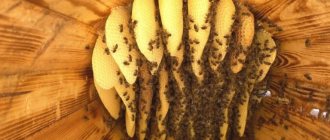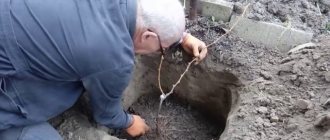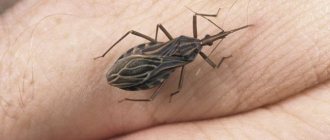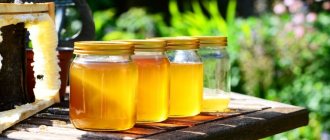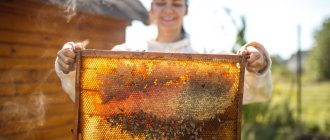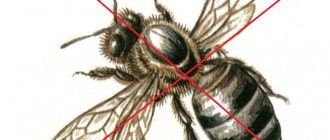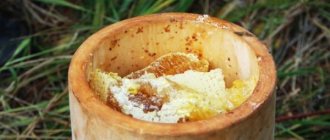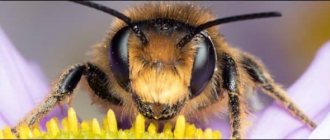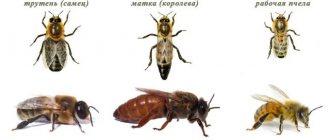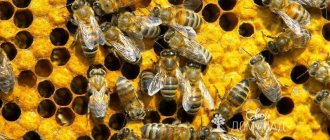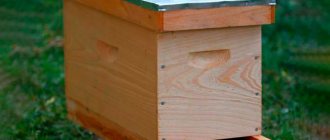Beekeeping in Bashkiria is one of the significant sectors of the national economy. Bashkiria can rightfully be called the capital of beekeeping and honey production. Statistics show that at the moment this republic is the leader among all Russian regions in nectar production. Since 1998, the number of bee families has been declining throughout the country, and in Bashkiria an annual five percent increase was recorded. Such a favorable development of the beekeeping industry was ensured by the experience accumulated over centuries, and the fact that it was literally passed on from generation to generation, that is, interest in this industry has not been lost over the years.
Beekeeping in Bashkiria is one of the significant sectors of the national economy
Development of beekeeping in Bashkiria
According to approximate data, Bashkir apiaries number more than 250,000 bee families. At first, as in many regions of Russia, the on-board type of honey extraction predominantly developed, and then the frame and log methods of beekeeping were mastered.
Beekeepers in Bashkiria have invaluable experience and knowledge in the field of running such a business and have been increasing it with enviable success over the years. For the most part, Bashkir apiaries are private property. But here you can find both scientific and state bee farms, where new breeds of bees are bred.
In 1998, a research center for beekeeping and apitherapy was founded. This state-owned enterprise has the right to use its own brand “Bashkir honey”.
In the institution:
- it is planned to develop a faster method for breeding bee families and healthy queens;
- one of the largest apitherapy bases has been created;
- a complex method of folk and traditional medicine is used, carried out by the structural division of the RCN and apitherapy.
The cosmetic and medicinal products of this institution earned a diploma at the 21st international exhibition “Safe and environmentally friendly products”. The list includes bath foams, shower gels, various creams, dishwashing detergents and much more. At the same time, you can see a wide variety of honey and adsorbed royal jelly on sale. The center’s activities are mainly aimed at expanding and preserving the distribution area of the breed bred in Bashkiria; they also organize the purchase of honey from beekeepers, process raw materials into the final product, and develop medicines based on beekeeping products and medicinal herbs.
Mass death of bees in Bashkiria: positions of the authorities and beekeepers
Spring and summer have become a time of great stress for beekeepers in Bashkiria in recent years. During this period, they have the hottest working time - caring for apiaries and collecting honey. However, since 2022, the region has seen an alarming trend of mass bee deaths. This has catastrophic consequences, ranging from monetary damages to business failure.
INVASION OF THE SILKWORTH
The situation in 2022 was aggravated by the invasion of the gypsy moth. At the moment, in five districts of Bashkiria, namely in Baymaksky, Zilairsky, Zianchurinsky, Kugarchinsky, Khaibullinsky municipalities, a state of emergency is in effect due to the pest. On their territory, forests are treated with chemicals, which include pesticides that are dangerous to bees.
The beekeepers of the Kugarchinsky district found themselves in an almost hopeless situation. Thus, Eldar Khabibullin from the village of Maksyutovo sounded the alarm on May 29. Then he noticed the first dead bees. At the beginning of the year, the man decided to leave the apiary in his yard while cultivating the agricultural fields, planning to take it out only in the summer. However, foresight did not help him - the bees died anyway.
Eldar noted that in a couple of days the forest, which is located 10 kilometers from the village, was treated for gypsy moths. The Ministry of Forestry told the UTV television channel that in the Kugarchinsky district the processing has been carried out since May 23. Villagers were warned about the start of work through the district newspaper, and information stands were installed at the entrance to the areas. During the treatment period, local residents are practically prohibited from going into the forest - they cannot graze livestock or collect herbs.
“Currently, pest outbreaks are treated by ground and air, using biological and chemical agents,” the department said.
Photo: social networks of Eldar Khabibullina
CAN CHEMICALS BE POISONED?
Farm fields near Maksyutovo were also treated with special substances. The Ministry of Agriculture noted that the drugs that were used cannot cause serious harm to bees, unlike insecticides.
“The fields are now treated with weed killers, not insecticides. They cannot cause global harm [to bees] unless you spray them. Namely, anti-insect preparations - if the wind blows from the place where they were treated by plane, this is already more destructive for the bees. This is an expert opinion, confirmed by specialists, including those from Moscow,” the department’s press service said.
It is noted that a commission is now working on site, which includes scientists, experts from the ministry and the veterinary department. Bee samples have already been sent to two laboratories, where they will determine why they died. So far, workers consider two causes of pestilence - illness and poisoning.
“ONLY WORKING TOGETHER CAN HELP”
In addition, the ministry recognized that the trend of bee deaths is primarily associated with poor interaction between farmers and beekeepers. Often, villagers are not warned about treatments and, as a result, are defenseless against insect pestilence. The only way, according to the Ministry of Agriculture, is to establish constant communication between the two spheres - beekeepers and farmers. In subsequent years, according to experts, the bee pestilence should stop altogether.
“We recognize that now both beekeepers and farmers need to work together and constantly keep in touch. Specialists organize interaction - chats are created and give announcements before processing. Everything is being done to ensure that information work is carried out constantly. Because now is the time to treat the fields with insecticides. We can solve the problem only by improving the interaction between farmers and beekeepers, because we cannot ban the cultivation of bread in the quantities that we need, since we are talking about food security. At the same time, Bashkir honey is our brand. Only communication and joint work can help,” the department noted.
A beekeeper from the Kugarchinsky district, Eldar Khabibullin, noted that he was not the only victim who lost his apiary overnight. According to him, colleagues from the villages of the municipality and even from other districts contact him.
“We are already receiving information from other beekeepers about the death of bees throughout the Kugarchinsky district. Tomorrow there will be several thousand poisoned bee colonies in the area,” the villager said.
The Bashkortostan prosecutor's office has begun an investigation into the death of bees. And the victims themselves also intend to contact laboratories to get an independent opinion on the causes of the pestilence of the hives.
Photo: vk.com/borismelkoedov
EVACUATION OF HIVES FOR RESCUE
The situation is almost similar in the neighboring Zilairsky district. The head of the municipality, Boris Melkoedov, called on beekeepers to move their apiaries from the forests of the region. On his page on social networks, he warned about the processing. The work will continue for a week, which in itself means the risk of death of bees. In his opinion, evacuating the hives is the only way to avoid pestilence.
“Consultation with specialists and sad experience allow us to conclude that the only effective way to preserve bees is transportation to places remote from processing. For the Zilairsky forestry, plots are proposed in the area of the villages of Yamansaz, Matraevo, Salimovo, Sidorovka, and for the Kananikolsky forestry - Ivano-Kuvalat, Russky Berdyash,” the head of the administration said.
According to the Ministry of Forestry, the invasion of gypsy moths in the region is observed on an area of 476 thousand hectares - the pests have taken over the forests. Insects show special love for birch, linden, oak and deciduous trees. Bashkir forests will be processed until June 10, both from the ground and from the air. Such measures should extinguish the outbreaks of the pest. The Ministry of Forestry itself stated that the outbreak of pests is a cyclical phenomenon. In subsequent years, the invasion should decline.
“There will also be a struggle, funds have already been allocated. Yes, the larvae eat the leaves, but the trees then recover,” the ministry explained.
Let us note that scientists warned about the threat of insect invasion back in 2019. Then the pests took over the forest plantations of the neighboring Orenburg region.
Bashkir apiaries
Bashkir apiaries are not only leading suppliers of honey and therapeutic, preventive and cosmetic products based on honey and herbs, but their products are worthy of the highest ratings in the opinion of the vast majority of the population of our country.
What is the secret of such excellent taste of Bashkir honey? Probably, thanks to many years of experience in beekeeping, all Bashkir apiaries have the best conditions for producing high-quality honey:
- a huge number of different honey plants;
- worker bees;
- beekeepers who have a wealth of experience in this field, the secrets of which have been passed down from generation to generation;
- there is a high-level educational base, any Bashkir beekeeper can study and receive an education at a technical school or institute;
- many enterprises in Bashkiria that specially manufacture beekeeping equipment;
- the most favorable legislative framework for the development of such activities.
Bashkiria can rightfully be called the capital of beekeeping and honey production
But the most important and starting advantage for the development of beekeeping is natural. It was the presence of rich vegetation and linden forests that became the prerequisite for the fact that beekeeping took root in Bashkiria. Beekeeping began to develop at a gigantic pace, supplying the entire country with delicious natural honey and medicines. The fields here are rich in sunflowers and buckwheat. In the steppes grow:
- clover;
- sweet clover;
- mustard;
- alfalfa;
- rape;
- a variety of legumes and other herbs.
Which Bashkir honey is the best?
There are several types of Bashkir honey, and it is impossible to say which one is better, since each variety has its own unique taste and beneficial properties.
The main types of honey produced in Bashkiria include:
- Lime. This variety belongs to the elite, it is characterized by a fine-grained consistency and a delicate delicate aroma of linden flowers. Freshly pumped honey is colorless, as it crystallizes it becomes white with a golden hue. It contains up to 37% glucose and 40% fructose.
- Steppe. This honey is considered polyfloral, as it is collected from different plants during their flowering period. The product has beneficial properties thanks to medicinal herbs, the nectar from which insects collect. Its color varies from whitish to golden amber. The steppe variety contains a large number of microelements and amino acids, due to which it stimulates all physiological processes in the human body.
- Prefabricated floral. Bees collect this type of honey from early spring to the first half of autumn. Dozens of species of mountain, forest and meadow plants are responsible for the unique bouquet of aroma. The color palette of the product is varied - from almost white to dark brown. This variety is distinguished by high nutritional and medicinal properties.
- Buckwheat. Nectar is collected from flowering buckwheat, honey has a spicy taste and a slight bitterness. The color of the variety ranges from dark yellow to reddish and dark brown.
How is beekeeping developing?
Beekeeping is the most basic form of beekeeping, the essence of which is to keep bees in tree hollows and obtain honey from them. In Bashkortostan there is still a corner where honey is extracted using this ancient method. The word “bort” itself means a beehive made in the form of a hollow or hollowed out block. In order to preserve and show people this unique, oldest form of beekeeping, the Shulgan-Tash nature reserve was created. By visiting it, you can not only learn the technology of the method and look at the hives, bees and their painstaking work, but also get acquainted with the history of the development of this industry in Bashkortostan. Back in the 18th-19th centuries, the well-known geographer and official Pyotr Rychkov wrote about the great talent of the Bashkir people in harvesting and processing honey: he noted that there are hardly any other people in the whole world who would give the country such delicious honey.
Beekeeping is the most basic form of beekeeping, the essence of which is to keep bees in the hollows of trees and obtain honey from them
In ancient times, almost every Bashkir family had at least one beehive. In order not to confuse them, they marked each hollow with a special sign, which they called “tamga”. The value of boards in those immemorial times was enormous; their value can be compared with the cost of an entire good-quality residential building. When the time came to give the quitrent, the cost of each board, each residential bee, each tree, each tamzhen tree, “the top removed”, for the self-sow and “where the bee sat” was separately indicated. A healthy tree is a bee, a living bee is a bee with bees, “where the bee sat” is a bee where there were bees before.
The removed top and the tamzhen tree indicated a tree that had already been prepared for a bead to be made in it in the near future.
The ideal conditions for the development of beet honey are the endless expanses of linden forests combined with tall pine trees. Such areas still exist in the Burzyansky district. In addition, in Bashkiria, a population of wild honey bees called Kyr Korto, which was listed in the Red Book, was preserved. This population arose due to climatic conditions in the Southern Urals.
On-board beekeeping in Bashkortostan
The origins of beekeeping by the Bashkirs
The first written mention of the Bashkirs living between the Volga and the Urals dates back to 922 AD. This is “The Book of Ahmed ibn Fadlan about his journey to the Volga in 921-922.” The book describes beliefs, customs, morals and, in particular, notes about honey production. “In their forests there is a lot of honey in the homes of bees, which they know and go to them to collect this honey.”
The Bashkir folk legend “Boshman-kypsak-batyr” says: “Once a terrible black army came from the direction of Altai. This force that suddenly appeared spread across the endless steppes, devastated the lands of the Tamyans, Kypsaks, Katayans, Burzyans, Telyavlins, and Yurmatyns. The Kypsaks, Cathayans and Burzyans tried to repel the enemy, but could not resist his countless army and were forced to hide in the forests and mountains.”
Pressed by the Mongol invasion, the Bashkir tribes fled to the north and northeast. Dense forests and rocky mountains protected them from the devastating raids of invaders. But nature here was not conducive to nomadic cattle breeding, so dear to the hearts of the steppe shepherds. In winter, deep snow fell and livestock died of hunger. If earlier the Bashkirs went far south for the winter, to the Aral Sea, now they were deprived of this opportunity. Hordes of conquerors occupied the steppe. Bashkir tribes settled in the forests.
Nomadic cattle breeding here proved difficult. The Bashkirs turned from steppe nomads into forest people. Their lifestyle changed: hunting and beekeeping became their main occupations.
Where and how did they learn this? The ancient Bashkirs are predominantly Turkic tribes of Central Asian origin. Their “ancestral home” is Altai, Southern Siberia, Mongolia, and northern Central Asia. The Bashkirs were steppe nomadic pastoralists. It is now reliably known that there were no honey bees in nature either in the whole of Siberia, or in Turkestan, or in Mongolia. Only in the 18th century, bees were brought from Bashkiria in log hives to the fabulously rich melliferous vegetation of Siberia, to the Southern Altai. The peoples of the Altai Mountains, related to the Bashkirs, did not engage in beekeeping. They began developing beekeeping immediately from log hives.
Before coming to the Ural forests, the Bashkirs were not engaged in beekeeping. This forestry trade in the Urals has long been common among the local Finno-Ugric peoples. The tools of beekeeping, which are almost identical among the Bashkirs and the ancient tribes of the Bakhmutin culture, indicate that the beekeeping of the Bashkirs goes back to the Bakhmut people.
Every war creates refugees. Together with their herds, the Bashkir tribes fled to the north and northeast from the Mongol conquerors. They were also joined by local settled peoples, displaced by the invaders. Being Finno-Ugric in origin, they had long since become related to the Bashkirs and understood their language.
The Horde yoke in Bashkiria lasted more than 300 years, much longer than in Rus'. These centuries were not only a time of oppression and predatory devastation of Bashkiria, but also a time of struggle and further formation of the nation.
The Bashkir legend “Akman-Tokman” says: “After some time, the khan sent his nukers to the Bashkirs. They were forced to submit to the khan. The land and waters were distributed among the clans. Each clan was assigned its own tamga, oran (cry), tree, bird. Our Cathay clan received a tamga - bagu, a cry - Salauat, a tree - pine. After receiving lands and tamga, the Bashkirs had to pay yasak to the khan.
At first, all this did not seem very burdensome. The forests and mountains were full of trees. In addition to yasak, there was still some honey left for ourselves. The forests and mountains were full of game, the furs were delivered on time. But one day a new decree came from the khan. Young men and boys with their horses and equipment were drafted into the Khan’s army. They began to steal horses and cattle in droves. The Bashkirs became unbearable, and they rose up against the khan.”
When the Golden Horde disintegrated and was divided into several khanates, the Bashkirs found themselves at the mercy of the Kazan, Nogai and Siberian khans. The conquest of Kazan by Ivan the Terrible and the fall of the Kazan Khanate made a huge impression on the Bashkirs, who languished under the Nogai and Siberian khans. They looked with hope at the Russian people, who had become the decisive force in the fight against the Tatar-Mongol conquerors. Different Bashkir tribes at different times sent their embassies to the Russian Tsar with a request to accept them as their citizenship.
During the annexation of Bashkiria to Russia, the Burzyans lived on the banks of the Belaya. In the 14th and early 15th centuries, moving up the Nugush and Belaya rivers, they settled in the mountain forest belt. At the same time, the Burzyan auls were founded on the very edge of the Ural taiga. This time, when the Burzyan people came to the southern bend of the Belaya and part of them settled, can be considered the origin of the Burzyan beekeeping.
There is a parable about this in the Burzyan village of Maksyutovo: “In ancient times, there were three bays in the village. Two of them had many borts and sold honey. They didn't keep a lot of livestock, only for their own needs. The third bai was called the stupid bai. He had a lot of cattle and few cattle. In dry years, hungry for food, his cattle died out, and he suffered losses. Bees produced especially a lot of honey in such years.”
Borti is mentioned in almost every document. Among the Bashkirs, side trees were something like real estate in all transactions.
Historical materials about beekeeping
In Bashkiria, even in the 18th century. Damage to side trees or their seizure was punishable by fines specified in the Code. When giving up their patrimony as a quitrent, the Bashkirs stipulated the cost of the boards separately: “... for each tree it was worth 10 kopecks, and for a living bee for a ruble 50 kopecks, and where the bee sat for a ruble, and for the removed top and tamzhena a tree costs 5 kopecks, and for a self-propelled feeder it costs 6 rubles.” “A busy tree” is a new board, a “residential bee” is a battle with bees, “where the bee was sitting” is a board that was previously inhabited by bees, “a removed top and a tamzhen tree” is a tree prepared for making a board.
Under Peter I, beekeeping and beekeeping in general fell into decline. His forest management affairs led to the expulsion of beekeepers from the forest. He not only limited the cutting of forests, but also prohibited the making of borti in these forests.
This was partly facilitated by the appearance of taverns in Russia: mead was replaced by vodka.
The situation with beekeeping in Bashkiria was somewhat better. In 1719, the Ufa governor Ivan Bakhmetyev sent a report that the Bashkirs and other foreigners were complaining that they could not do without oak, elm and pine. Oak and pine go to the boards, and they pay yasak from the income of beekeeping. The arguments were apparently convincing. In the same year, residents of the Ufa province, as well as the Siberian and Astrakhan provinces, were allowed to freely cut down forests, with the exception of places where timber was harvested for ship construction. This permission not only saved the Bashkir linden from complete destruction, but also stopped the expulsion of beekeeping from our forests, which began under Peter I.
In the second half of the 18th century. beekeeping in Bashkiria reached its peak. It was widespread.
At this time, the first written works about beekeeping in Russia appeared, and they concerned specifically Bashkiria. These are articles by an Orenburg nobleman, later a famous historian, the first corresponding member of the Academy of Sciences, Pyotr Ivanovich Rychkov. It was published in 1767-1769 in the Proceedings of the Free Economic Society. Rychkov supplied his works with interesting drawings.
In addition to P.I. Rychkov, the expeditions of Lepekhin, Pallas and Falk passed through the Bashkir region along different routes. All these travelers collected rich natural and ethnographic material. Lepekhin wrote and published his works in Russian. His books are difficult to overestimate. The descriptions of the Bashkir people and the nature of our region given by Lepekhin are distinguished by their reliability and detail. From his works, for example, information was obtained that among the Bashkirs many families had five hundred, and some a thousand, borts, from which they received significant income from honey and wax. Poor Bashkirs were hired by the rich. One man could cope with two hundred boards. Most of the Bashkirs did not hire workers; they worked as a whole family, not excluding very old people.
Thanks to the illustrations of articles by P.I. Rychkov, it is possible to recreate the airborne fishing of the Bashkirs in the 18th century.
The Bashkirs, for the most part, sold the honey and wax they broke out of the sides without refining them. Buyers came to them from different cities and counties to buy honey. But some, having a large number of beards, refined the honey and took it themselves to fairs in the cities. Cleaning was done as follows. The honey broken out of the sides was placed in cauldrons and placed in a warm place. The wax in the hot honey floated to the top. It was removed, and pure honey was poured into linden tubs - batmans. But the best honey was considered to be the one that, once established, raises the foundation to the top by itself. Even more than two hundred years ago, it was well understood that heat treatment of honey in order to give it a marketable appearance reduces its quality.
The removed wax was squeezed out and melted. The Bashkirs themselves had no need for wax. It was exclusively for sale. They left enough honey for their own needs. They consumed it both in its natural form and as a drink for themselves and their guests.
Of course, this drink has nothing in common with honey mash - the mead with which drunkenness began. It was done in a very special way. Both the method of preparation and its use are very similar to koumiss. A sourdough starter (“bash”) is also needed, into which the fresh product is poured, it sours, and it is also drunk after a few hours. The drink, similar to kumiss, gives a very light intoxicating effect that quickly passes without any hangover. It remained forgotten, although the Bashkirs have long considered it beneficial to health; they said that this drink “strengthens their nature.”
Every year many borts were made in the forests, and they served for centuries. As P.I. Rychkov pointed out, there were families that owned thousands of bees, but only a small fraction of them generated income and were populated by bees. Hence, it is quite understandable that the Bashkirs developed techniques that helped lure free swarms into their borders. Onboard fishing techniques have improved.
There were the happiest bees, well populated with bees for many years. Each such board was, as a rule, covered with a legend, which was reflected in the name.
In the mountain-forest zone, in the forests of the middle reaches of the Karaideli and the upper reaches of the Agidel, the swarming system of beekeeping persisted for about 200 years, existing until the fifties of the 20th century.
Onboard fishing has improved over time. Swarm system in the second half of the 18th century. became too wasteful. Bashkir forests, rich in wild swarms of bees, were mercilessly cut down for the needs of iron and copper smelters. Now the beekeepers, taking the honey, sought to save the family. Apparently, the beginning of the use of smoke by the Bashkirs in working with bees should be attributed to this time, for they began to work closely with residential sides.
However, it would be a mistake to assume that the swarm system became obsolete everywhere in the second half of the 18th century. It was the Western Bashkirs who left it first; it was them who P.I. had in mind. Rychkov. In the mountain-forest zone, the swarming system of beekeeping persisted for another 200 years, existing until the fifties of the 20th century.
ABOUT BOARD SIGNS.
Since ancient times, Bashkirs have applied signs (tamga) to things, trees and stones. They had a certain traditional meaning, to some extent a legal basis. According to epigraphists, these signs had the first features of writing. According to legends and historical information, family signs appeared among the Bashkir tribes when they were under the yoke of the Golden Horde. Genghis Khan assigned each tribal leader a tamga, an oran (cry), a tree and a bird. These attributes had the meaning of the heraldry of modern states.
Forced to submit to the khan, the Bashkir tribes received land and paid yasak. Since those distant times, tamga has become a badge of honor for them. The Bashkir tribes (Yryu, Il) in turn united several clans (Tyuba, Aimak). They (the clan) were a set of clan divisions (ara, aimak, population), consisting of closely related families along the male line of descendants. Each tribe had its own name, tamga and tribal territory, divided into ancestral fiefdoms.
As the tribal nobility grew stronger in the 13th-15th centuries, the decomposition of clan relations deepened. At the same time, not only the content of generic and tribal signs changed, but their forms also underwent significant changes. The fragmentation of tribes and clans into new groups and their mixing with related neighbors and with alien ethnic groups led to the integration of attributes of different origins, including clan and tribal signs.
Bashkir side trees were considered real estate, had a mark of distinction (tamga) of some kind and were mentioned in documents under this sign. As the tribal system collapsed, Bashkir bean hunters within their hunting grounds began to mark beet trees with their own sign, which became their property. The owners of the borti within the boundaries of their former tribe added their own individual sign to the preserved common sign, distinguishing their own borti from the borti of their relatives. The pedigree signs applied by the owner to the border trees indicated both the right of ownership of the border and the right of ownership of the land of this tract. Without the written consent of the owner of the berms, no one had the right to use the berm lands. This legal attitude was widespread in the 17th century among the local Bashkir population. Therefore, in each individual case, the right to use the sides on foreign territory was specifically stipulated.
Each side sign (tamga) had its own name. Among the Bashkirs, signs were divided into groups related to the life and activity of humans, as well as those depicting domestic animals, birds, amphibians, etc. In particular, there are tamgas depicting farming tools: pitchforks, rakes, sickles, etc.; objects used in everyday life: ladle, rocker, bowl, tripod; other items: stirrups, horseshoes, bridles, saddles, etc., as well as those characteristic of the letters of runic writing.
The tamga marked not only the bead tree, but also the tree in which it was planned to make the bead in the future. Over the course of decades, this tree reached its standard thickness and height. It was very important to predict whether the fight would be successful. A large council of boarders gathered to decide whether it was worth making this board in one place or another. At the same time, the proximity of honey plants and clean water, the thickness of the tree, the purity of the preparation, and the possible direction of flight of the bees were taken into account. The intuition of the old boarders was of great importance when choosing the location of the board. It largely depended on this whether the flight would be successful. Game birds, which were also marked with tamga, were considered a very valuable find. Usually, long-term reserves of honey accumulated in it, and there was much more of it there than in the borti. Findings of wild hollows were discussed separately in documents and often became the subject of serious controversy.
Each bortevik was engaged in the production of beads himself. There were also specialized specialists who cut off the tops of supposed berm trees or chiseled beads. Such work was very expensive.
The borteviks could tell the “biography” of each of their borti, called them by name, identified the sweetest ones, in which swarms willingly settled, and the honey ones, which gave more honey than others for a whole century.
On some berm trees you can observe several bead marks of various shapes. These are those successful sides that were sold or presented as a gift by the owner on the occasion of some significant date (wedding, birth of a child, etc.) to another owner. The new owner cut his tamga next to or above the old owner's tamga. The borti could be transferred to another bortevik in the event of the death of the owner. In a forest area, the sides of several owners were usually mixed. Each knew his own well and never encroached on the property of others. The sign of ownership protected the board from ruin and appropriation by others and was considered inviolable.
The continuity of the forms of the side signs suggests that this craft was inherited from father to son. If one beekeeper had several sons and they all began to engage in beekeeping, then the sons should have had their own sign, different from their father’s in some characteristic element. The father's side sign was inherited by the youngest son.
The variety of side signs arises not only due to the addition of some dash or line to the main sign, but there is some pattern in the change in tamga and the appearance of their variations. Various forms of signs can arise due to the location of the main sign in a horizontal, oblique, inverted position, or the merging and summing of them.
Many side signs are similar to the letters of runic writing, and some are no different from them. Tamgas in the form of runic letters were also used by the Turkic peoples of Central Asia, Western Siberia and Altai.
Side signs were very important. Usually they were applied to the tools of the bortevik or to any other tools and utensils. Many Bashkirs put their side sign on documents instead of a signature or seal. Such documents had legal force.
Below are the signs of bortevik, which have been preserved on the bortevik trees of the Shulgan-Tash nature reserve and in the adjacent territory. Some side signs were restored based on the results of the survey. More than half of the listed side signs have specific owners, mostly of advanced age. But young people are also trying to preserve and learn more about their family signs. As a result of the crisis in beekeeping in the region, interest in onboard beekeeping has greatly increased in recent decades. Therefore, some beetroot growers again began to mark their beetroot trees outside the reserve with tamga. And in the reserve, each bort tree is numbered and a log is kept for each bort.
see also
Burzyan side bee
Story
Boring on a tree in the Shulgan-Tash nature reserve
Beekeeping in Bashkortostan is the oldest type of craft; evidence of this is the findings of the Birsky burial ground, which is about one and a half thousand years old: among the utensils there, complete beekeeping equipment was found.
Beekeeping in Bashkortostan developed in several directions: wild, beekeeping, distillation, log, frame.
The beads (soloҡ) were hollowed out in trees (oak, linden, larch, pine, less often elm) at a height of 4-12 m. The beads served for up to 150 years. Many families had more than a hundred boarders. Side trees were inherited, and the owner's tamga was placed on them. The value of the land was also due to the fact that honey was part of the tribute.
Beehives in the Chekmagushevsky district of the Republic of Bashkortostan Flowering of a valuable honey plant - linden Flowering bruise in the Ishimbay region - a very valuable honey plant, from 1 hectare bees extract 300-400 kg of honey
On-board fishing with a swarming system in which bees were smoked with sulfur dioxide (the bees suffocated and died from the thick toxic smoke) was improved. In the second half of the 18th century, Bashkir beekeepers, taking honey, already sought to preserve the bee family.
Bashkir beekeeping was first described in 1767-1769 by P. I. Rychkov in the article “On keeping bees” and in “Proceedings of the Free Economic Society”. In the descriptions of the scientist I. I. Lepekhin in the 18th century of the Bashkir people, information is given that some Bashkir families had from five hundred to a thousand borts, from which they received honey and wax. Poor Bashkirs were hired by the rich, while one person coped with two hundred boards. But most of the Bashkirs did not hire workers, but worked in the beekeeping farm with the whole family, including very old people.
At the end of the 19th century, frame beekeeping was introduced in Bashkiria and the first apiaries were organized in frame hives.
By the early 50s of the 20th century, the transfer of bee colonies from logs to frame hives was completed in the Bashkir Autonomous Soviet Socialist Republic. In remote villages of the mountain-forest zone, frame hives are common in collective farm and state farm apiaries; private bees are kept in log hives; there are bees in the forests with the Burzyan bee aboriginal bee. To train beekeepers, Lyakhovskaya (1892) and Klyucherevskaya (1910) three-year beekeeping schools were opened.
The foundations of scientific beekeeping in Bashkortostan were laid in 1930 with the creation of an experimental beekeeping station and the training of beekeepers at the Yumatovo Beekeeping College in 1932. Since 1964, the Department of Beekeeping was opened at the Bashkir Agricultural Institute.
Scientists - beekeepers R. R. Aznabaev, G. S. Borovik (Iglinsky district), S. N. Kilinbaev, R. M. Latypov (Kugarchinsky district), I. K. Onishchenko (Sterlitamak district) in favorable years, they received 70-100 kg of honey from each bee colony.
In the 60s of the 20th century in the BASSR there were 200-220 thousand bee families on collective and state farms. Honey production in the Republic of Belarus from public apiaries amounted to 1.5-2.0 thousand tons.
Bashkiria is the only place in Europe where on-board beekeeping has been preserved
The all-Russian public organization “Slow Food in Russia” initiated a project - annual gastronomic expeditions “In Search of the Lost”. It is very important for us to preserve rare endangered national products, to draw attention to forgotten tastes, we want to find local producers, talk about them, support small productions and give them our signature slow food impulse: tasty, honest, clean.
The first expedition took place in Chuvashia, where we searched for and tasted local beer, which the Chuvash have been brewing at home since time immemorial.
The second gastronomic expedition was dedicated to beekeeping, wild honey, and the Burzyan bee of Bashkiria. Historically, Nadezhda Bragina and Rishat Galeev became one of the brightest supporters of Slow Food in the Southern Urals. Nadezhda was elected vice president for youth policy at Slow Food Russia, Richat became a honey supplier to the International Space Station, and an active supporter of preserving on-board beekeeping in Russia. From our point of view, “all the stars came together” in Bashkiria to preserve the unique fishery. On the one hand, there are Slow Food supporters, businessmen, scientists, and beekeepers who are vitally interested in preserving the local bee population and traditional way of life. the Burzyan aboriginal bee preserved in purity (link: https://www.fondazioneslowfood.com/en/ark-of-taste-slow-food/bashkir-bee/) (included in the “Ark of Taste”), well, actual on-board honey, the production of which is only a few tons per year for the entire republic.
Our goal is to talk about beekeeping and try to create a security project “Presidia”, because all the components of the international project Slow Food International for the protection of biodiversity, conservation of territory, breed, and traditional technology for the production of a unique food product are available.
The expedition took place in early August 2022. The timing was not chosen by chance; we arrived before the busiest time of the year for beekeepers. The end of August-September is the time for collecting wild honey; if we had arrived a little later, we would hardly have received so much attention. In beekeeping, if you miss a day, you lose a year. The final destination of our expedition was the state natural biosphere reserve “Shulgan-Tash” (link: https://shulgan-tash.ru/), the only one in the world that protects the indigenous Burzyan population of the dark forest bee in its natural habitat. This is where the breeding apiary is located, where a unique bee is bred.
So, everything in order.
beekeeping
The history of onboard beekeeping goes back centuries. For the first time, frescoes on a beekeeping theme were discovered in Valencia and Albecete. Images of honey hunters and bees hovering around them were found in Egypt, India, Italy, and Germany. It’s hard to believe now, but beekeeping was once practiced throughout Europe. Today, this ancient type of craft has been preserved in its original form, only in Bashkiria, where this craft has been practiced since the middle of the first millennium, and possibly earlier. Bashkir airborne dynasties are a separate topic for a big conversation. From father to son, skills, tools, and beekeeping “tricks” have been passed on for centuries. Beethorn trees are equivalent to real estate, they are inherited from generation to generation, they are always chosen close to honey-bearing meadows and clean water, there are no harmful industries nearby. There is also a local taboo - a “stranger” should never touch the tree where the beads are located. The generic sign “tamga”, which was used to mark a tree, may contain marks of several generations of one kind of beekeepers. Can you imagine what feelings modern beetroot farmers experience when they see the ancestral tamga on a tree, made by the hand of their great-grandfathers?!
The sides are hollowed out from trees with a diameter of at least 60-90 cm and a height of 18-25 meters. One to four sides can be placed on one tree. In order to protect the boarding from unwanted guests (primarily bears), they are installed at a height of 4 to 16 meters. For protection, all sorts of tricks are used: bars, doors... right down to the beaters that push the lover of sweets to the ground
The Burzyan bee and the people who preserve it
The Burzyan bee (Apis mellifera mellifera) is a local population of the dark forest (Central Russian) bee, living in the forests of the mountain forest zone of the Republic of Bashkortostan. Listed in the Red Book of the Republic of Bashkortostan and the Chelyabinsk Region.
The Bashkir bee is called the gold of Bashkiria. According to this allegory, the Burzyan bee can safely be considered a diamond. The fact is that only Burzyan bees can overwinter in the forest; they are perfectly adapted to local agroclimatic conditions, frost and thaw, and are also resistant to many diseases.
In 1928-1929, professor at Moscow State University. M.V. Lomonosova G.A. Kozhevnikov organized an expedition of the USSR Academy of Sciences to Bashkiria and described the habitat of the bee bee, which coincided with the territory of the Burzyansky district of Bashkiria. For almost a century, a whole generation of researchers studied the behavior of the “Burzyanka”, its biological characteristics, genetics, engaged in selection, and preserved this breed of bees for the future: E.M. Petrov, G.I. Chiglintsev, I.V. Shafikov, Kh.A. Sadykova, R.G. Nugumanov, F.G. Yumaguzhina, A.Ya. Sharipov, M.V. Bakalov and many others. Today, work to preserve the “burzyanka” is actively supported by the director of the Shulgan-Tash reserve Mikhail Nikolaevich Kosarev, scientists of Bashkiria Alexey Nikolenko, Elena Saltykova, entrepreneur Sergey Mulyukov and others.
The preservation of the Burzyan bee is associated not only with traditions, but also with the preservation of the biological brand of the Republic. There will be no Burzyan bee, there will be no beekeeping - a unique business, an art, if you like, will disappear. Anyone who has at least once seen how a beetroot grower climbs a tree, masterfully arranges a workplace for himself, tying a special stand under his feet, and slowly and very carefully extracts beetroot honey, will agree with us. The spectacle is fascinating! In many ways, beekeeping is an art - an extremely developed skill that requires special skills. Only trained, skillful, hardworking people can become bortevik workers. By the way, we did not see a single bortevik who was overweight.
“Burzyanka” is a special bee that has a very aggressive character. During the expedition we experienced this ourselves. The attack of wild bees cannot be compared with anything! There is no buzzing or warning flights around, everything is done with lightning speed, any exposed parts of the body are stung in a big way: arms, legs, head. We, unprepared for such attacks, dashingly ran to the cars, and only there did we find shelter. "Burzyanka" are not only warlike, but also loyal bees. It is very difficult for them to replace the uterus with a new one due to attachment to the old one. When inspecting the hive, she is afraid of light. Therefore, there are many nuances when working with local bees related to special tools and behavior of the bee.
On-board honey
Obviously, such a unique wild bee will have special honey. Unfortunately, the strategic adaptive advantages of the Burzyan bee are offset by the demands of the market, where there is a demand for cheap honey, sometimes of extremely low quality, but beautifully packaged and in large quantities. It is difficult for the average person to determine the quality of honey, and it is even more difficult to force oneself to overpay if there is a jar of honey nearby that is several times cheaper than on-farm honey.
According to the most stringent international standards, on-borrow honey from the Burzyan region of Bashkiria is an environmentally friendly product. The appearance of on-board honey is unusual and at first glance may even puzzle a buyer who is accustomed to a transparent product of all shades of amber, floral linden, creamy texture and without impurities. Honey from wild bees is collected in combs of irregular shape and without frames, so it is difficult to separate honey from other bee waste products. This honey is mixed with beebread and wax, has several shades, mostly dark in color and is superior to other types of honey in terms of the amount of useful substances.
Undoubtedly, the wild dark forest bees of Bashkiria are the strategic oldest gene pool of bees in the world as a whole. It has been proven that this species of Bashkir bee is the ancestor of the prehistoric dark bee. By the way, there is a hypothesis that the bees of Altai (the recognized honey region of Russia) have Bashkir roots. The main difficulty in maintaining the Burzyanka population is that local dark forest bees interbreed with imported breeds. There is a “erosion” of the gene pool. Hybrids of the first generation can survive, but later the bees degrade and they lose their adaptability.
Work on preserving and breeding purebred local bees must begin immediately. In order to preserve the Burzyan bortevsky dark Central Russian breed, the will and efforts of local leaders, scientists, bortevik specialists, legislative decisions, genetic research, painstaking breeding work, preservation of the bee’s habitat and even expansion of the boundaries of the reserve will probably be required. Protecting the local bee from interbreeding with other bee breeds is one of the main tasks.
Can our organization help the “Burzyanka” and the on-board truck drivers of Bashkiria? Of course: with your experience, advice, knowledge, capabilities, authority. I really want to hope that the global network of Terra Madre, the Presidia project, will be replenished with a new object of conservation and protection - Burzyan on-board honey! We will be able to preserve the Burzyan bee, preserve the traditions of beekeeping, preserve beekeeping honey!
In 2022, the 47th Congress of the International Federation of Beekeeping Associations "Apimondia", which unites 118 beekeeping unions from 82 countries, will be held in Ufa, the capital of Bashkiria. The main task of the organization, created in 1893, is to promote the scientific, technical and economic development of beekeeping in all countries. Apimondia congresses are held every two years.
We are confident that on-board honey and the Burzyan bee will take their rightful place in beekeeping in the world at the international forum. Slow Food to help them!
Yuri Stolpovsky
The expedition was organized by the All-Russian public organization “Slow Food in Russia” and its regional branch in the Republic of Bashkiria, the Interregional Association for Coordinating the Activities of Producers and Processors of Beekeeping Products, LLC PC “Bashkir Honey”, in collaboration with the Shulgan-Tash Nature Reserve and the Ufa Institute of Biology of the Russian Federation. Academy of Sciences.
- Did you learn something new from this page?
- yes
Current state
Honey production in the Republic of Bashkortostan
Based on the results of research conducted at the State Budgetary Institution BNIC (State Budgetary Institution Bashkir Research Center for Beekeeping and Apitherapy), the parameters of the main economically useful traits and biological characteristics of Bashkir bees were identified:
- the body weight of bees when leaving the cells is 110-115 mg, of barren queens - 190-195 mg, of fertile queens - 210-215 mg, of drones - 235-255 mg;
- The body color of bees, queens and drones is dark gray, without yellow elements on the tergites; honey signet - white (“dry”);
- winter-spring mortality of bee colonies - no more than 3-5% of the number available on the day of the autumn audit;
- food consumption per street of overwintered bees is on average about 1.0-1.2 kg of honey;
- The egg production of queens during the period of intensive spring-summer development of bee colonies is 2 thousand eggs per day.
To date, the number of apiaries and the volume of honey produced in the republic is decreasing, which is due to the environmental situation in the republic.
Beekeepers of Bashkortostan participate in exhibitions and beekeeping competitions for beekeepers of the republic.
On July 2, 1997, a law on beekeeping was adopted in Bashkortostan. The law describes issues of participation of the state and citizens in the development of beekeeping, taxation, state control and protection of bees, issues of placing apiaries, and recording the number of bee colonies.
A beekeeping agency has been created in the republic; inter-district branches of the Agency with subordinate regional trade and procurement centers; District beekeeping inspectors work in charge of trading and procurement points. A single Beekeeper's Day of the Republic of Bashkortostan has been established - the second Sunday of August.
The Bashkir population of bees is distinguished by winter hardiness, resistance to European foulbrood, nosematosis and honeydew toxicosis, as well as high honey productivity with a short honey collection (for example, from linden). Bashkir bees have a dry seal of honey that is highly valued by beekeepers.
The southern steppe Bashkir regions of the Trans-Urals are characterized by the lowest number of bees. The northern, central and southern regions of the Urals are most saturated with bees. The total number of bee families in Bashkortostan in 2001 was about 255 thousand (an average of 11 years - 233 thousand), and the average honey productivity per bee family was 16 kg.
Currently, work is underway in the republic to revive the on-board fishery. So in 2004, there were about 200 bee colonies in the Shulgan-Tash nature reserve (in 1927-908 families).
Beekeeping in Bashkiria
Beekeeping is the oldest craft of the indigenous population of Bashkiria. Initially, probably like everywhere else, honey and wax were obtained simply by destroying the found bee nests, then they started beekeeping on board (somewhere in the 15th century), then log beekeeping came, and then frame beekeeping, which is still developing today.
In terms of industry development, beekeeping in Bashkiria occupies one of the leading places among the constituent entities of the Russian Federation and is among the top 7 constituent entities in terms of the number of bee families and the production of marketable honey, so in Bashkiria in 2012 there were more than 309,000 bee families (in 2005 there were 278.1 thousand bee families). In Russia, the number of bee colonies decreases every year, but in Bashkortostan, since 1998, an annual increase of 4-10% has been observed. Although, data on the number of bee families varies: for example, according to the results of the 2006 All-Russian Agricultural Census, there are 315,800 bee families in the republic.
The largest number of bee families (400 thousand) in the republic was in the 1960s. Currently, there is a tendency to reduce the number of bee families and honey production in public apiaries, but in amateur apiaries the number of bee families and the volume of honey production are increasing.
The republic has the necessary conditions for the development of beekeeping:
- rich natural and cultivated honey-bearing vegetation;
- a unique Bashkir population of honey bees (the so-called Burzyan bee, popularly known as Burzyanka);
- centuries-old traditions and high skill of beekeepers;
- educational institutions for training beekeepers;
- enterprises for the production of bee equipment and foundation;
- demand for Bashkir honey and bees of the Bashkir breed in the Russian and world markets;
- legislative basis for the development of the beekeeping industry.
What is this legislative framework? So back in 1995 (in the first of the constituent entities of the Russian Federation) the Law of the Republic of Bashkortostan “On beekeeping” was adopted. In 2005, the concept “Development of beekeeping in the Republic of Bashkortostan until 2010” and the republican target program “Development of beekeeping in the Republic of Belarus” for 2006-2010 were developed and adopted. In December 2012, the “Concept for the development of beekeeping in the Republic of Belarus until 2022” was adopted, thanks to which it is planned to increase the number of bee colonies to 480,000.
At the same time, there are factors hindering the effective development of the industry:
- insufficient number of breeding apiaries for breeding the Bashkir population of honey bees, as well as the unsatisfactory state of the material and technical base of existing breeding apiaries;
- placement of apiaries without taking into account the characteristics and ecological state of the republic’s natural zones;
- felling of forests without taking into account the interests of the beekeeping industry, insufficient production and sale of honey plant seeds to farms and the population;
- lack of an effective system for recording the number of bee colonies and the volume of beekeeping production in the private sector;
- ineffective use of highly qualified personnel and low qualifications of beekeepers + imperfect wage system in the beekeeping industry;
- insufficient number of beekeeping stores in some regions and cities of the republic + high prices for inventory and equipment;
- uncontrolled import of queen bees, families and packages of bees from the southern regions of Russia and neighboring countries, leading to crossbreeding of the Bashkir breed of honey bees.
Pollution of the natural environment with industrial waste and the use of insecticides in agriculture have a detrimental effect on the development of beekeeping. Industrial chemical waste, getting into nectar and pollen pollen, poses a danger not only to bees, but also to humans who consume bee products.
Legislative framework for beekeeping in Bashkortostan
What is this legislative framework? So back in 1995 (in the first of the constituent entities of the Russian Federation) the Law of the Republic of Bashkortostan “On beekeeping” was adopted. In 2005, the concept “Development of beekeeping in the Republic of Bashkortostan until 2010” and the republican target program “Development of beekeeping in the Republic of Belarus” for 2006-2010 were developed and adopted. In December 2012, the “Concept for the development of beekeeping in the Republic of Belarus until 2022” was adopted, thanks to which it is planned to increase the number of bee colonies to 480,000.
At the same time, there are factors hindering the effective development of the industry:
- insufficient number of breeding apiaries for breeding the Bashkir population of honey bees, as well as the unsatisfactory state of the material and technical base of existing breeding apiaries;
- placement of apiaries without taking into account the characteristics and ecological state of the republic’s natural zones;
- felling of forests without taking into account the interests of the beekeeping industry, insufficient production and sale of honey plant seeds to farms and the population;
- lack of an effective system for recording the number of bee colonies and the volume of beekeeping production in the private sector;
- ineffective use of highly qualified personnel and low qualifications of beekeepers + imperfect wage system in the beekeeping industry;
- insufficient number of beekeeping stores in some regions and cities of the republic + high prices for inventory and equipment;
- uncontrolled import of queen bees, families and packages of bees from the southern regions of Russia and neighboring countries, leading to crossbreeding of the Bashkir breed of honey bees.
Pollution of the natural environment with industrial waste and the use of insecticides in agriculture have a detrimental effect on the development of beekeeping. Industrial chemical waste, getting into nectar and pollen pollen, poses a danger not only to bees, but also to humans who consume bee products.
The first law on beekeeping was adopted back in 1995, then 10 years later, a special framework began to be developed, which was based on the development of beekeeping in this republic. The concept was adopted in 2012 and is valid until 2022. To date, the Law of 2105 insists on increasing bee colonies to 480 thousand.
The 2015 Law also draws attention to the problems that prevent beekeeping from fully developing in Bashkiria:
- Small population of honey bees due to lack of breeding apiaries.
- Logistical problems.
- Uncontrolled placement of apiaries, not taking into account the state of the environment.
- No records are kept of the number of bee colonies.
- Highly qualified personnel are practically not used.
- Lack of special beekeeping equipment.
The 2015 law provides for the maintenance, breeding, and protection of the honey bee. Monitors veterinary and sanitary standards.
Honey plants of Bashkortostan
A third of all linden forests in Russia are located in Bashkortostan. In the mountain forest areas, significant thickets of Norway maple and willow have been preserved. The diversity of wild honey plants is complemented by large areas of cultivated nectar plants. In Bashkiria there are over 50 spring honey plants, more than 100 species of summer honey plants and about 30 species of late summer and autumn. According to other data, there are about 300 species of honey plants in the republic.
In the forest-steppe and steppe zones, large areas of agricultural crops of melliferous importance are cultivated: buckwheat and oil sunflower; legumes, perennial grasses: red clover, alfalfa, sainfoin, sweet clover (yellow and white), oriental goat's rue (galega), as well as mustard and spring rape crops. In many regions of the republic, various melliferous plants of hay and pasture lands have a certain importance.
Potential honey reserves in the republic are about 525,500 tons, of which honey bees can use 173,400 tons, which makes it possible to productively support 1,347,000 bee families, which is four and a half times more than currently.
Natural conditions of Bashkiria
The Republic of Bashkortostan occupies part of the eastern edge of the East European Plain. The western part of this subject of the Russian Federation is flat, the eastern part is mountainous. The specificity of the region is that the main part of its territory is covered with forests, in which there are significant areas of honey plants. No other region of the Russian Federation has forests of such scale and quality. This, together with the special climatic conditions and rich flora, make Bashkortostan one of the most favorable regions for the development of beekeeping.
Bashkir honey
This is bee honey collected from meadows and forests in the territory of Bashkortostan. The highly valued properties of Bashkir honey are determined by natural climatic conditions and unique rich vegetation. The following types of Bashkir honey are distinguished: linden, buckwheat, sweet clover, sainfoin, meadow, forest.
Of great value as a medicinal product is honey collected from forest and meadow plants, many of which are natural medicinal raw materials (nectar plants - oregano, motherwort pentaloba, dandelion, burnet, sage and pollen plants - rose hips, St. John's wort, plantain and others) .
The awards of Bashkir honey are also widely known, here are some:
- “awarded the Gold Medal for Ufa honey at the Paris World Fair in 1900”
- “awarded the Gold Medal for linden honey at the first International Exhibition in Erfruit (GDR) in 1961”
- “awarded the Silver Medal at the XX International Congress of Apimondia in Bucharest (Romania) in 1965”
- “a Gold Medal was awarded to Bashkir honey at the XXIII International Congress in Moscow in 1971”
- “Bashkir honey was awarded the highest award at the International Exhibition “Green Week” in Berlin in 2002”
In 2005, the State Institution “Bashkir Scientific Research Center for Beekeeping and Apitherapy” (GU BNICPiA) received a certificate for the right to use the appellation of origin of the product “Bashkir honey”, issued by Rospatent.
Bashkir honey was also included in the daily diet of astronauts at the Mir orbital station.
Features of Bashkir honey
Genuine Bashkir honey is not only a delicacy, but also a valuable medicine created by nature itself. Possessing a unique aroma, taste and unique composition of microelements, this honey has no analogues in the world. In addition to grape and fruit sugars , it contains vitamins, amino acids, enzymes, hormones, and a large amount of mineral and aromatic substances. At international exhibitions held in Europe and Russia, Bashkir honey regularly receives a large number of awards. It is definitely included in the diet of Star City specialists during the pre-flight preparation period, as well as cosmonauts working at orbital stations.
The valuable properties of Bashkir honey are determined by the special climatic conditions, the richness and originality of the flora of Bashkortostan. The specificity of the region is that most of its territory is covered with forests, including vast areas of honey-bearing vegetation. There are no forest areas of this quality and scale anywhere else in our country.
Honey is collected from trees, shrubs, and medicinal plants that grow in abundance in these forests. In addition to the usual species, such as chamomile, St. John's wort, rose hips, valerian, motherwort, sage, oregano , there are rare herbs such as thyme, cornflower, silky wormwood, steppe timothy, spring adonis, feather grass and others. The composition of Bashkir honey is being studied by scientists from many countries, but so far no one has been able to artificially create such a healing composition.
Beekeeping in Bashkiria
Beekeeping, or the extraction of wild forest honey, arose in this region in ancient times and has survived to the present day. Bortya was an old tree in whose hollow wild bees had settled. People extracted honey by looking for hollow trees with bee housing.
Honey production - how bees make honey
Later they began to create artificial sides, for which old pine or larch trees were used. at a height of approximately 12 m from the ground. A person moved up the tree, clinging to specially made notches with his feet and securing his own body with a leather or bast belt.
They installed a footrest at the required height and began to hollow out a hollow, into which several splinters were then attached, and the entrance was closed with wooden slats. Several holes were made between them, into which wild bees could fly . The bees found such “houses” and willingly settled in them. In mid-summer, beekeepers began collecting wild honey. Bortis could last for more than 100 years and were usually passed down through generations.
The breed of wild bees living in the forests of Bashkiria is called Burzyan. These bees are able to withstand any frost. Unfortunately, being an endangered species, they are listed in the Red Book. Most of them are located in the special bee reserve “Shulgan-Tash”. Today, the republic is carrying out a whole range of measures to revive beekeeping.
About Bashkir beekeeping from the author
Everything written above is a retelling of Bashkir beekeeping from official sources (books, newspapers, official documents). What is it really? What kind of beekeeping is Bashkiria like?
What kind of hives do beekeepers in Bashkiria use? These are wooden beds, two-body Dadans (sometimes with 1-3 magazines or with a third body), multi-body Ruta hives (with 5 and 6 bodies), polystyrene foam Bee-Box hives (of various configurations), single-body Dadans with a frame magazine Ruta. Some people invent their own beehive systems, some master cassette pavilions, others use polyurethane foam hives.
How many bee colonies do beekeepers in Bashkiria have? This is where the real discrepancy is: from one to several hundred. Some people keep a couple of hives to provide their family with honey, others keep 20-30 families at their parents’ dacha or in the village and receive additional income from the sale of honey. There are also professionals - those with apiaries of 100, 200, 300 or more bee colonies, who receive their main income from bees.
Import of bees of southern breeds. That's what it is, that is. Indeed, bee packages and queens of southern breeds - Carpathians - are imported uncontrollably into Bashkiria (both from the Mukachevo region of Ukraine and the Stavropol Territory, and from Uzbekistan). The press (“Who will stop the flying invaders?” - Origins, June 9, 2010) also writes about the importation of bees of the gray mountain Caucasian breed. Moreover, this problem began about 15-20 years ago - they go for bee packages for resale themselves, they are brought almost by trucks... There is nothing surprising: the prices for such packages are low, there is a demand, so they carry them. To solve the problem, breeding apiaries and affordable prices are needed, but this cannot be done without government help: who will invest money to preserve “some kind of bee”? I'm afraid that by the time they take up this matter it will be too late.
